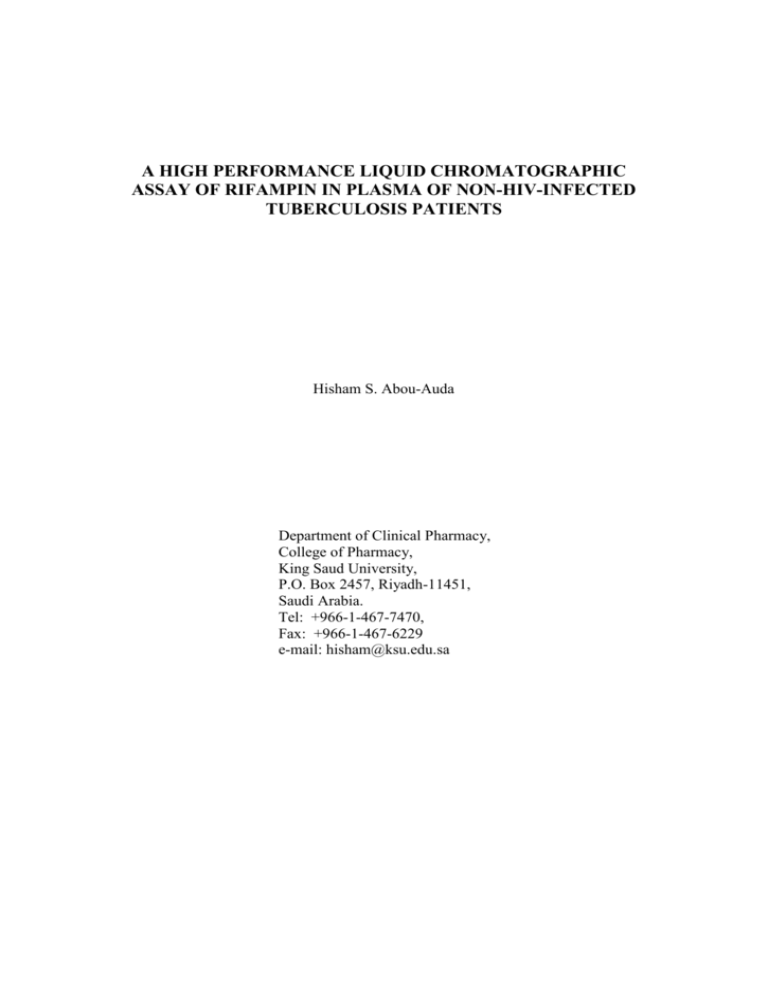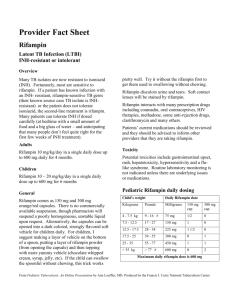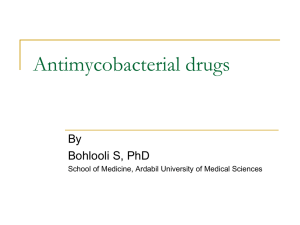a high performance liquid chromatographic assay of rifampin in
advertisement

A HIGH PERFORMANCE LIQUID CHROMATOGRAPHIC ASSAY OF RIFAMPIN IN PLASMA OF NON-HIV-INFECTED TUBERCULOSIS PATIENTS Hisham S. Abou-Auda Department of Clinical Pharmacy, College of Pharmacy, King Saud University, P.O. Box 2457, Riyadh-11451, Saudi Arabia. Tel: +966-1-467-7470, Fax: +966-1-467-6229 e-mail: hisham@ksu.edu.sa ABSTRACT INTRODUCTION Rifampin (rifampicin) is a bactericidal for Mycobacterium tuberculosis. It inhibits mycobacterial DNA-dependent RNA polymerase synthesis by blocking RNA transcription (Ref). Most strains of Mycobacterium tuberculosis are inhibited in vitro by rifampin concentrations of 0.5 μg/ml (Ref). Rifampin is quickly absorbed from the gastrointestinal tract with peak serum concentrations of 6-8 μg/ml occurring 1.5-2.0 hours after administration. It is 75% bound to plasma proteins (Ref) and it is metabolized in the liver to an active metabolite, deacetylrifampin and undergoes enterohepatic recycling (Ref). Preliminary data suggest that patients infected with mycobacteria have altered pharmacokinetic profiles for rifampin due to malabsorption of the drug, which contributes to the observed low rifampin levels in the serum of these patients (Ref). The resulting subtherapeutic levels may seriously affect the therapy outcome. For these reasons, therapeutic drug monitoring (TDM) of rifampin in tuberculosis patients may play a strategic role in improving the therapeutic outcome in selected patients (Ref). The other important indications for TDM of rifampin are the management of interaction between rifampin and other antituberculosis drugs (Ref) and the evaluation of antituberculosis drug compliance in these patients (Ref). The reported methods for the assay of rifampin in the plasma of patients with active tuberculosis are lacking sensitivity and specificity. Many of these methods involve a time-consuming sample preparation and extraction and a very lengthy elution time. MATERIALS AND METHODS Apparatus A HPLC system was used consisting of model LC-10AT liquid chromatograph (Shimadzu, Kyoto, Japan), an autosampler model WISP-712 (Waters, Milford, MA, USA), model 480 UV/VIS variable wavelength detector set at 337 nm (Waters, Milford, MA, USA), in combination with a data module integrator model 746 (Waters, Milford, MA, USA). Chromatographic separations were accomplished using a μBondapak C18, 10 μm, 150 mm3.9 mm stainless steel column (Waters, Milford, MA, USA) with a guard precolumn of the same packing material. Reagents Rifampin was used as received from……. Ascorbic acid (as stabilizing agent) from Sigma chemicals (St. louis, MO, USA), tetracycline hydrochloride (as internal standard) was obtained from Boehringer Mannheim GmbH. Methanol and phosphoric acid were HPLC grade (BDH chemicals, Poole, UK). All other chemicals and reagents were of analytical grade. Standard Solutions Rifampin (50 mg) was dissolved in distilled water in a 50-ml volumetric flask. Ascorbic acid (25 mg) was added and volume was completed to 50 ml with water to produce a stock solution of 1 mg/ml. The internal standard, tetracycline HCl (10 mg), was dissolved in 10 ml of distilled water to give a 1-mg/ml stock solution. The solutions were stored at 4°C and they were stable for, at least, two weeks. Chromatographic Conditions The mobile phase consisted of methanol and 0.01 M phosphate buffer of pH 5.2, adjusted with phosphoric acid (55:45 v/v). The mixture was filtered through 0.22 μm membrane (Millipore, Bedford, MA, USA) under vacuum, then degassed by flushing with nitrogen for 5 min. The mobile phase was pumped isocratically at a flow rate of 1.2 ml/min during analysis, at ambient temperature. The chromatograms were recorded and integrated at a chart speed of 0.25 cm/min. The effluent was monitored at 337 nm at sensitivity of 0.02 AUFS. Analytical Procedure Sample preparation and analysis were conducted at room temperature. Rifampin stock solution (1 mg/ml) was added to 15 ml graduated centrifuge tubes in volumes of 0.5, 10, 25, 50, 100 and 150 μL (5 mg of ascorbic acid was added to each tube). Drug-free human plasma was added to complete volume to 10 ml, and vortex-mixed for 30 sec to yield final calibration standard concentrations of 0 (no rifampin added), 0.5, 1.0, 2.5, 5.0, 10 and 15 μg/ml. Each of these standard solutions was distributed in disposable polypropylene microcentrifuge tubes (1.5 ml, eppendorf) in volume of 0.5 ml and stored at -70°C pending analysis. For preparation of sample for injection onto HPLC system, a 10-ml aliquot of the internal standard (tetracycline HCl, 1 mg/ml) was added to 0.5 ml of plasma sample, and then 0.5 ml of methanol was added to the tube. The tube was shaken for 1 min on a vortex-mixer and then centrifuged at 13000 rpm for 20 min. Aliquots were loaded in the autosampler tray and volumes of 50 μL were injected into the chromatograph. Clinical Study The study was conducted on Saudi adult patients admitted to King Khalid University Hospital (KKUH) with active pulmonary tuberculosis. Treatment with rifampin was initiated and relevant clinical and laboratory information for each patient, including all concurrent medications, were recorded. Eight patients received standard therapy for tuberculosis for one week and plasma samples were drawn after 2 hr of the last dose of rifampin. REFERENCES 1. Peloquin CA, Namdar R, Singleton MD, Nix DE. Pharmacokinetics of rifampin under fasting conditions, with food, and with antacids. Chest 1999; 115:12-18. 2. Lau YY, Hanson GD, Carel BJ. Determination of rifampin in human plasma by highperformance liquid chromatography with ultraviolet detection. J Chromatogr B Biomed Appl 1996; 676(1):147-52. 3. Conte JE Jr, Lin E, Zurlinden E. Liquid chromatographic determination of rifampin in human plasma, bronchoalveolar lavage fluid, and alveolar cells. J Chromatogr Sci 2000; 38(2):72-6. 4. Peters JH, Gordon GR, Murray Jr, Ichikawa W, Gilber RH, Welch TM, Goucher CR. Measurement of rifampin in plasma: chemical vs bacteriologic assay. Proc West Pharmacol Soc 1977; 20(-HD-):211-5. 5. Le Guellec C, Gaudet ML, Lamanetre S, Breteau M. Stability of rifampin in plasma: consequences for therapeutic monitoring and pharmacokinetic studies. Ther Drug Monit 1997; 19(6):669-74. 6. El-Yazigi A, Raines DA. Simultaneous microdetermination of rifampin, deacetylrifampin, isoniazid, and acetylisoniazid in plasma by liquid chromatography with dual electrochemical and spectrophotometric detection. Pharm Res 1992; 9(6):812-6. 7. Argekar AP, Kunjir SS, Purandare KS. Simultaneous determination of rifampicin, isoniazid and pyrazinamid by high performance thin layer chromatography. J Pharm Biomed Anal 1996;14(11):1645-50. 8. Smith PJ, van Dyk J, Fredericks A. Determination of rifampicin, isoniazid and pyrazinamide by high performance liquid chromatography after their simultaneous extraction from plasma. Int J Tuberc Lung Dis 1999; 3(11 Suppl 3):S325-8; discussion S351-2. 9. Guillaumont M, Leclercq M, Frobert Y, Guise B, Harf R. Determination of rifampicin, desacetylrifampicin, isoniazid and acetylisoniazid by high-performance liquid chromatography: application to human serum extracts, polymorphonucleocytes and alveolar macrophages. J Chromatogr 1982; 232(2):369-76. 10. Chan K. Rifampicin concentrations in cerebrospinal fluid and plasma of the rabbit by high performance liquid chromatography. Methods Find Exp Clin Pharmacol 1986; 8(12):721-6. 11. Oldfield S, Berg JD, Stiles HJ, Buckley BM. Measurement of rifampicin and 25desacetylrifampicin in biological fluids using high-performance liquid chromatography with direct sample injection. J Chromatogr 1986; 377(-HD-):423-9 12. Ishii M, Ogata H. Determination of rifampicin and its main metabolites in human plasma by high-performance liquid chromatography. J Chromatogr 1988; 426(2):4126. 13. Lecaillon JB, Febvre N, Metayer JP, Souppart C. Quantitative assay of rifampicin and three of its metabolites in human plasma, urine and saliva by high-performance liquid chromatography. J Chromatogr 1978; 145(2):319-24. 14. Jamaluddin AB, Sarwar G, Rahim MA, Rahman MK. High-performance liquid chromatographic assay of rifampicin in human serum. J Chromatogr 1990; 525(2):495-7. 15. Swart KJ, Papgis M. Automated high-performance liquid chromatographic method for the determination of rifampicin in plasma. J Chromatogr 1992; 593(1-2):21-4. 16. Ratti B, Parenti RR, Toselli A, Zerilli LF. Quantitative assay of rifampicin and its main metabolite 25-desacetylrifampicin in human plasma by reversed-phase highperformance liquid chromatography. J Chromatogr 1981; 225(2):526-31.








